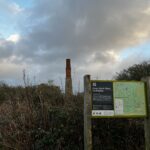
As I left the serene Germoe Parish Church, I felt a rush of anticipation for my next destination: the Great Work Mine, nestled near the quaint village of Balwest. I entered the narrow Cornish roads, flanked by towering lush green hedgerows that blocked a view of the landscape. These winding paths were so narrow that they barely accommodated a single vehicle, transforming each blind corner into a thrilling encounter.
Before long, I found myself face-to-face with a white Land Rover. The driver and I exchanged surprised glances, each of us stopped in our tracks. With no room to pass, she graciously reversed a hundred yards back to a farm entrance. As I pulled alongside her, I rolled down my window to express my gratitude. She apologized for her reversing skills, but I assured her that navigating these roads was a new adventure for me. When she inquired about where I was from (obviously not a local), I mentioned I was visiting from near Toronto, Ontario, Canada. To my surprise, she revealed that her daughter lived in Toronto and had just visited. We shared a laugh about how small the world really is, especially on a narrow, hedgerow-lined lane in rural Cornwall. With a wave, we parted ways, each continuing our journey.
A few minutes later, I arrived at the unassuming entrance to the Great Work Mine. The first thing that caught my eye was the towering chimney stack, rising above the treeline, guiding me to the site.
The Great Work Mine rests in the valley between Godolphin Hill and Tregonning Hill on the Godolphin Estate.
True to its name, this mine was once a grand operation. Its history stretches back to at least 1540, and remnants of its storied past still linger. As I explored, I stumbled upon the remains of a water-pumping engine house and chimney stack from the early 1800s, along with several outbuildings now lost to overgrowth. The mine shaft, a daunting 180 feet deep to the water drainage tunnel (the adit) and 1,000 feet to the bottom, was secured with metal grating.
Even with this protection, I felt a shiver of nervousness standing at the edge of a hole as deep as the First Canadian Place tower is tall.
To truly grasp the significance of Cornish mines in my family history, I must turn to William Lemon, the elder brother of my 7x great-grandfather, Samuel Lemon.
The family’s roots were humble, their lives entwined between Breage and Germoe. My researchers speculate that William began working in the mining industry at a young age, likely at the smelting works at Chyandour, near the Parish of Gulval. It was there, in 1724, that he married Isabella Vibert, who brought a substantial dowry that allowed him to take a gamble on a mining venture called Wheal Fortune at Trowel Farm near Ludgvan. His risk paid off, yielding profits upwards of £10,000—nearly $5 million today. This newfound wealth paved the way for his investment in the Gwennap copper mines, ultimately establishing him as one of the wealthiest men in the county. His journey continued as he became Mayor of Truro and Sheriff of Cornwall by 1741, even serving as a stannator, collecting tax on refined tin for the Duchy of Cornwall. I believe it was his relationship with the Duke of Cornwall (Frederick, Prince of Wales) that granted him a 23-year lease for exploration on Duchy lands, allowing him to reap a percentage from every copper mine established—to him, a meager investment of £1,100, that propelled him to extraordinary heights of wealth and influence.
As a huge fan of the Poldark television series, set in Cornwall during the late 18th century, I often find striking parallels between my family’s history and the characters brought to life by Winston Graham. These connections are not solely mine; as Bernard Deacon explores in his book, The Real World of Poldark, many see reflections of the Lemon family in Graham’s work. If you’ve delved into the Poldark books or watched the adaptations, you’ll appreciate Deacon’s insights. Winston Graham certainly did his research!
Though the timeline of Poldark is set about 40 years later, I often draw comparisons between William Lemon and characters like George Warleggan, whose rags-to-riches story echoes William’s own. While William’s narrative is one for another time—one I plan to explore further in an upcoming post—his brother Samuel’s life remains somewhat obscured, perhaps in the shadow of William’s accomplishments.
We do know that in 1754, Samuel purchased a 1/48 share of the Great Work Mine, which he held for many years. It’s believed he was a mine captain before taking on the risk of becoming a shareholder. Just six years later, he acquired a lease on the dwelling house and land at Trennal Farm from the Earl of Godolphin, cementing his ties to the land and the mine. Trennal Farm, conveniently located just down the road from the Great Work Mine, allowed Samuel to oversee his investment and daily operations with ease.
As I wandered around the Great Work Mine site, completely alone, I couldn’t help but reflect on the research that had brought me here. Standing on the very ground where Samuel had worked tirelessly, taking great risks, I felt a profound connection to my ancestors. Samuel’s journey was not without its ambitions; he purchased several houses in Germoe and nearby Goldsithney and Perrannuthnoe, perhaps aspiring to emulate his brother’s success.
Investing in tin and copper mines in the 18th century required a person who was ambitious, visionary, and resilient—someone willing to embrace uncertainty and navigate the many risks involved. They needed to be bold enough to dream of great success, yet practical enough to endure the challenges that came with such speculative ventures. These individuals were often driven by a desire for wealth, social status, and the thrill of turning a high-risk investment into a remarkable fortune. Learning about them has taught me an invaluable lesson about the strength, ambition, and perseverance that run through my own veins—reminding me of the foundations from which I’m made.
The Great Work Mine has experienced many changes since its closure in 1930, nearly 400 years after it first opened, and just over 100 years after our family’s involvement. Today, it is under the stewardship of the National Trust, a testament to its enduring significance in our shared history.













